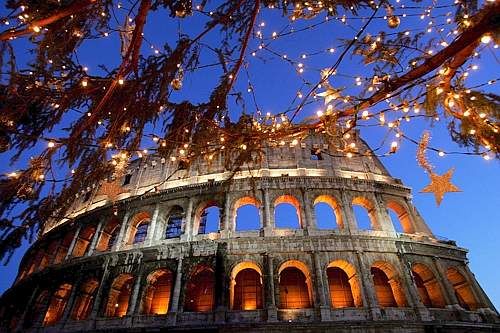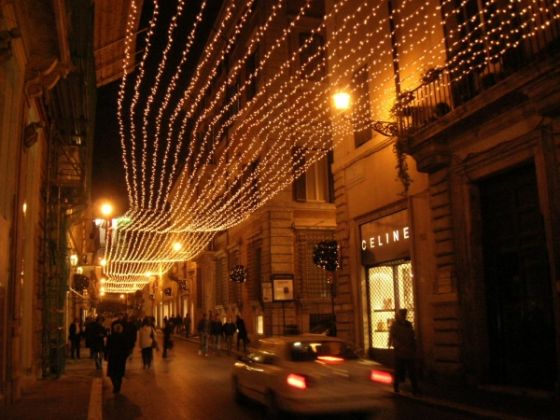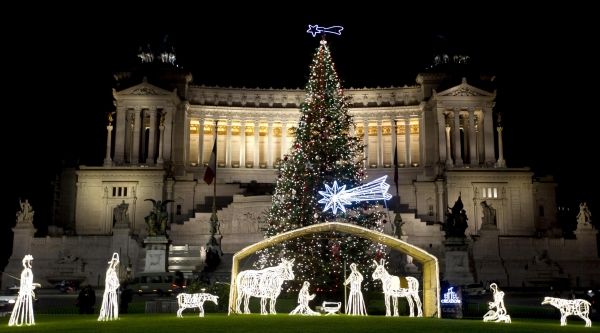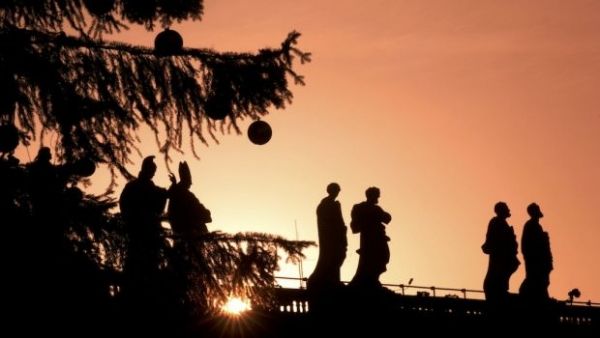A Roman Christmas involves food, family and traditional festivities
The festive season in Rome begins with the Feast of the Immaculate Conception on 8 December when Pope Francis lays a floral wreath at the statue of the Madonna near the Spanish Steps. Around this time Romans begin decorating their homes with Christmas trees, nativity scenes, and seasonal plants such as the poinsettia and butcher’s broom, an evergreen shrub spotted with red berries.
It begins to look a lot like Christmas all over the city too. Streets are strung with twinkling lights and shop windows become seasonal snapshots. Besides the general splendour, there are some holiday highlights worth taking a look at.
One particularly bright spot in the festivities is Rome’s third edition of the “Roma si mette in luce.” In past years the programme included traditional light displays as well as high-tech shows on maxi screens across the city. ATAC joined in the action last year and decked out the exterior of one or two electric buses with LED lights.
There are many classical concerts in the city's churches, although they are often announced at the last minute. The main Christmas concerts in mid-December (see under What’s On events) take place at S. Cecilia, featuring the JuniOrchestra; Accademia Filarmonica featuring Pablo Colino and his choir; and the Auditorium Conciliazione whose annual Concerto di Natale this year features international musicians such as Patti Smith and Dolores O'Riordan as well as Italy's Giovanni Allevi and Alex Britti.
For something traditional, visit the nativity displays at Palazzo Ruspoli near Piazza del Popolo. The annual Centopresepi, or 100 cribs, exhibition displays nativity scenes ranging from modern renditions to 16th-18th century models. An original Italian decoration, it’s widely believed that the first presepio was made in 1223 by St Francis of Assisi. You can visit the oldest one in existence, Arnolfo di Cambio’s 1289 marble version at the Basilica di S. Maria Maggiore, or a life-sized construction in St Peter’s Square. For the last 60 years Italian members of the global crib-building association Friends of the Crib build a traditional-style crib in the church of S. Maria in Via off Largo Chigi each year, as well as constructing large cribs in Piazza Navona and Piazza S. Pietro. Also the parish churches have their cribs on display all over the city.
Piazza S. Pietro also displays the Vatican’s Christmas tree. Given to the holy state by a different country each year, the tree lights up the square throughout the holidays and then its wood is crafted into toys for children in need. The capital’s tree is displayed in the middle of Piazza Venezia.
Children can get their photographs taken with Babbo Natale in Piazza S. Silvestro or see 30 of his doppelgängers on the Santa Bus, which gives tours of the city. Auditorium Parco della Musica also organises various events including Santa appearances and ice-skating.
To encourage the commercial rush but circumvent traffic jams the capital usually adds free buses to shopping hotspots. So ditch your car and hop on the “Linea Shopping” to get your gifts. There is also a plethora of Christmas markets to check out, including the traditional one in Piazza Navona.
After the frantic pre-celebration preparations, most Roman families gather on Christmas Eve to share a fish dinner. Afterwards many of them attend midnight Mass at their local parish church or the Papal Mass in St Peter’s Basilica at 21.30. A few hours later, on Christmas morning they exchange presents before heading to the pope’s Urbi et Orbi message at noon. Dinner, enjoyed around a decorated table, entails a meat dish followed by panettone, a traditional Italian cake, or torrone, Italian nougat.
Expats who are remaining in Rome over the festive season and who want to recreate their own traditional British/American Christmas meal can find most of the necessary ingredients at the city's Castroni food shops.
On New Year’s Eve, known as the Festa di S. Silvestro in Italy, the traditional meal consists of cotechino (a product similar to salami), zampone (stuffed pig’s trotter), and lentils which are meant to bring luck for the coming year, all of which is washed down with a glass of prosecco or spumante. The other well-known but almost-extinct tradition (in southern Italy at least) associated with capodanno involved people throwing old objects out the window, symbolising their readiness to welcome in the new year. The city normally provides a free New Year's Eve concert which is followed by a giant fireworks display.
On New Year's Day one of the city's most unusual and popular sights takes place at midday at Ponte Cavour. Immediately after the cannons fire on the Gianicolo, daredevil divers thrill the crowds by making the 17-metre plunge, known as the Tuffo nel Tevere, into the icy waters of the Tiber below.
The celebrations don’t conclude there. On 6 January, Italians celebrate the religious Feast of the Epiphany or the more popular one of La Befana. In the Bible tradition the feast of the Epiphany is when the three magi arrive in Bethlehem to visit the Christ child. In the popular tradition of the Befana the story goes that the wise men invited a witch to join them on their journey to bring gifts to the Christ child. She initially refused, but then tried to follow them. Unable to find Jesus she gave the toys to other children. Now children hang stockings by windows or fireplaces in anticipation of her visit to receive sweets if they’ve been good or coal if they have misbehaved. The story is reenacted each year in Piazza Navona and the witch’s departing flight marks the end of the holiday season.
Sarah Barchus


























